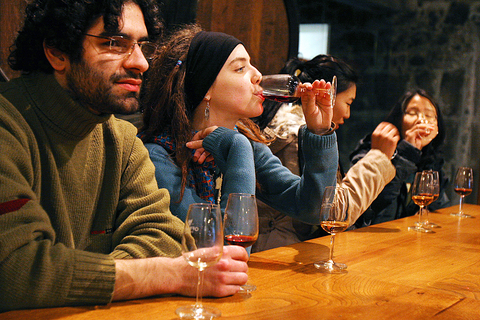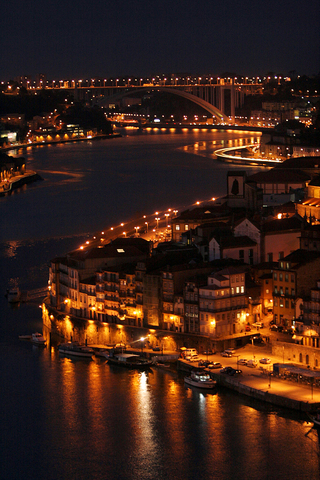Mention Oporto, and one tends to think of well-fed British gents puffing postprandial cigars as they sip garnet-colored wine and solve the world's problems before rejoining the ladies in the drawing room. But what that word — the name of Portugal's second-largest city — ought to conjure is an almost impossibly picturesque town of Gothic, Renaissance and Baroque buildings cascading down a steep gorge to the banks of the Douro River just before its waters reach the blue Atlantic.
Six stunning bridges — including two designed by Gustave Eiffel and one of his students, and each a marvel of engineering — loom hundreds of feet above. No wonder UNESCO declared the whole city center a World Heritage Site in 1996.
Thanks to the likes of Evelyn Waugh and P.G. Wodehouse, however, Oporto has been overshadowed by its principal export, port wine. Wines have been traveling downriver from the Douro Valley almost since the Romans founded the town of Portus Cale. A millennium later, the English developed such a taste for the stuff that they bought up most of the wineries — hence names like Graham's and Sandeman — and, after expelling Napoleon's army, had to be evicted from the city themselves.

PHOTOS: NY TIMES NEWS SERVICE
But sweet wine does not a modern city make, and Oporto has been keeping itself busy of late. There are the new concert hall by Rem Koolhaas, an outstanding contemporary art museum and a thriving gallery scene, not to mention a whole riverfront of lively bars and restaurants.
Things are even changing in the fabled vineyards upriver as younger generations of winegrowers update their staid family businesses with an emphasis on lighter varietal wines that want to be uncorked today rather than in 40 years. The traditional flat-bottomed rabelo sailboats that once brought the wine casks downriver continue to ply the waters, though now they haul tourists who come to bask in the city's glow of intensely saturated colors and crystal-clear light, which can be just as intoxicating as any vintage port.
Assuming you've got a good pair of walking shoes in which to trek up and down the steep hills of the historic center, most of Oporto's major monuments can be reached on foot. Presiding over the whole scene is the Se Catedral, with its Gothic cloister and gorgeous 18th-century tiles, which dates back to the 12th century. Next door is the Bishop's Palace, a white grand Baroque facade punctuated by gray curlicue stone window frames. It almost takes precedence over the church itself.

Before taking the inland route down the hill, step out onto the upper level — now used for pedestrians and the city's metro — of the Dom Luis I Bridge, built by one of Eiffel's disciples, to get a bird's-eye view back to the hilltop medieval city and the remnants of its 14th-century fortifications.
The streets that fan out behind the cathedral are home to many of its best-known shops, including the Lello Bookstore, in a marvelous neo-Gothic building. Brace yourself with a coffee at the grand Art Nouveau Cafe Majestic before tackling the 225 steps of the Torre dos Clerigos for yet another breathtaking view of the city and river.
Also not to be missed is the vestibule of the Sao Bento train station, a monument to the Portuguese love affair with painted tiles (there are 20,000 of them there). Farther downhill is the Igreja de Sao Francisco, in which someone appears to have detonated an explosion of carved and gilt Baroque ornament inside a decidedly more austere — but no less impressive — 14th-century Gothic church.
After expanding into new neighborhoods for much of the last century, Oporto is in the midst of recolonizing its most romantic neighborhood, the Ribeira, as the arcaded warren of former bacalhau warehouses along the river is known. Near the Casa do Infante, the former home of Portugal's favorite son — the 15th-century maritime exploration figure Henry the Navigator — and now a museum of city history, you'll find a cluster of clothing stores like Favela Chic and Shade, selling pan-European hipster wear to Oporto's modern progeny.
Stretching in both directions from the Praca da Ribeira, the rows of weathered tile-clad buildings almost appear to be holding each other up. Above the omnipresent laundry drying on the balconies, women in floral housedresses lean over the railings and watch city life stroll, sail, cycle or just drift by. Down at street level, stylish interior design shops line up next to Internet cafes and intimate wine bars.
At Presuntisco, diners are greeted by robust garlic bread, tartly marinated green olives and roasted dates wrapped in cured ham. There, you can tuck into a lunch of tangy goat cheese topped with sultanas and toasted nuts; caldo verde, the traditional Portuguese cabbage soup; and a plate of alheira de Caca, a garlicky sausage of game served over rice. Wash it all down with a bottle of crisply refreshing vinho verde, the young white wine with just a hint of effervescence.
Across the river, along the waterfront in Vila Nova da Gaia, the rows of old port warehouses offer tastings of their traditional wines, with Ramos Pinto offering one of the most evocative experiences. The wharf ends in a cluster of lively restaurants and bars with names like Afrodisiaco, Vinotinto and Real India, underscoring the city's embrace of things modern and international.
A more bohemian scene can be found back at Maus Habitos, the current clubhouse for Oporto's chilled-out youth culture. On the fourth floor of a nondescript office building behind the cathedral, it is a popular vegetarian restaurant by day and a sort of updated 1960s happening at night. A few people there sell handicrafts and homemade cakes and even give massages, but for those who really need to unwind, there are some very stiff cocktails, and a DJ spins excellent 1980s and 1990s house music.
For a real taste of Oporto present, book a table for dinner at Foz Velha in the chic Foz do Douro neighborhood overlooking the crashing waves of the Atlantic. Plan to spend the evening strolling the neighborhood's eclectic shops -- sunglass stores, interior design studios and trendy boutiques like Clube Chocolate — many of which stay open until about midnight.
Another reason to venture out into the new city is the Serralves Museum of Contemporary Art by the Pritzker Prize-winning Portuguese architect Alvaro Siza Vieira. It plays host to exhibitions of cutting-edge international contemporary art, and the museum shop stocks some of the best of Portuguese design, like the boldly architectonic silverware of Ana Fernandes.
But the city's newest architectural gem is the even more recent Casa da Musica, which opened in 2005 with a Lou Reed concert. Mr. Koolhaas' design looks like a faceted meteorite that slammed into an otherwise tranquil neighborhood of broad boulevards. At the top-floor restaurant Kool, the Italian chef Augusto Gemelli makes culinary waves with his original takes on authentic Italian fare, like rigatoni in a tomato sauce tempered with the sweetness of grapes.
However multifaceted Oporto has become, it hasn't forgotten its vinicultural roots. The Alto Douro wine region is itself a UNESCO World Heritage Site, and 2006 marked its 250th anniversary as a demarcated wine region, making it the oldest designated wine region in the world. A trip upriver — be it by boat, car or helicopter — reveals a landscape of steep hills terraced into vineyards and dotted with centuries-old quintas, as the wineries are called, most of which are open to the public.
At the historic Quinta da Pacheca all grapes are pressed by foot in old granite tanks, and visitors are invited to join in during the harvest in September and October.
The nearby Hotel Vintage House, with its sweeping views of the river and terraced hillsides, is worth checking out for lunch, or better yet checking in overnight. Bookings for harvest time should be made well in advance, though. The hotel director, Paulo Teixeira de Carvalho, said: "That is when everyone wants to come. The whole valley is one huge party."

Even by the standards of Ukraine’s International Legion, which comprises volunteers from over 55 countries, Han has an unusual backstory. Born in Taichung, he grew up in Costa Rica — then one of Taiwan’s diplomatic allies — where a relative worked for the embassy. After attending an American international high school in San Jose, Costa Rica’s capital, Han — who prefers to use only his given name for OPSEC (operations security) reasons — moved to the US in his teens. He attended Penn State University before returning to Taiwan to work in the semiconductor industry in Kaohsiung, where he

On May 2, Chinese Nationalist Party (KMT) Chairman Eric Chu (朱立倫), at a meeting in support of Taipei city councilors at party headquarters, compared President William Lai (賴清德) to Hitler. Chu claimed that unlike any other democracy worldwide in history, no other leader was rooting out opposing parties like Lai and the Democratic Progressive Party (DPP). That his statements are wildly inaccurate was not the point. It was a rallying cry, not a history lesson. This was intentional to provoke the international diplomatic community into a response, which was promptly provided. Both the German and Israeli offices issued statements on Facebook

May 18 to May 24 Pastor Yang Hsu’s (楊煦) congregation was shocked upon seeing the land he chose to build his orphanage. It was surrounded by mountains on three sides, and the only way to access it was to cross a river by foot. The soil was poor due to runoff, and large rocks strewn across the plot prevented much from growing. In addition, there was no running water or electricity. But it was all Yang could afford. He and his Indigenous Atayal wife Lin Feng-ying (林鳳英) had already been caring for 24 orphans in their home, and they were in

Australia’s ABC last week published a piece on the recall campaign. The article emphasized the divisions in Taiwanese society and blamed the recall for worsening them. It quotes a supporter of the Taiwan People’s Party (TPP) as saying “I’m 43 years old, born and raised here, and I’ve never seen the country this divided in my entire life.” Apparently, as an adult, she slept through the post-election violence in 2000 and 2004 by the Chinese Nationalist Party (KMT), the veiled coup threats by the military when Chen Shui-bian (陳水扁) became president, the 2006 Red Shirt protests against him ginned up by